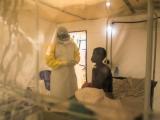Jul 10, 2008 (CIDRAP News) – European officials today reported a rare case of the often-deadly Marburg hemorrhagic fever on European soil, in a Dutch woman who recently was exposed to bats while visiting caves in Uganda.
Dutch authorities informed the European Union and the World Health Organization of the case today, according to a statement from the European Centre for Disease Prevention and Control (ECDC). The patient is a 40-year-old woman who had recently returned from a vacation in Uganda.
"The travel included a visit to two caves in the Maramagambo forest (between Queen Elizabeth Park and Kebale), where she was exposed to fruit bats," the ECDC said. The patient was at Leiden University Medical Centre; her condition was not disclosed.
"ECDC's initial assessment is that the threat to public health is limited and mainly focused on the people who have been in close contact with the patient after the onset of her symptoms," the agency said. "People intending to travel to Uganda should be aware there may be a risk related to visiting caves in the Maramagambo forest."
The Marburg virus, like its cousin the Ebola virus, can cause a severe febrile disease for which there is no vaccine or specific treatment. The case-fatality rate ranges from 30% to 90%, depending on the strain, according to an ECDC fact sheet. The most recent large Marburg outbreak occurred in Angola in 2004 and 2005, involving 252 confirmed cases with 227 deaths.
Marburg and Ebola can spread through contact with blood, secretions, or other body fluids of living or dead infected persons, and also through contact with living or dead infected animals, according to the ECDC.
The natural reservoir for Marburg virus is unknown, but last year researchers reported finding genetic material from the virus in a species of fruit bat in Gabon. The bats might have been a reservoir for the virus, or they might have acquired it from some other animal, the researchers said.
See also:
Aug 22, 2007, CIDRAP News story "Traces of Marburg virus found in African bats"
CIDRAP overview of viral hemorrhagic fevers
http://www.cidrap.umn.edu/cidrap/content/bt/vhf/biofacts/index.html

















